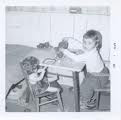Today is the National Day of Listening. Black Friday? Today is the National Day of Listening! Check this link on The Books For Walls Project or go right to the Story Corps website for more. Instead of going to the mall, project leaders suggest, listen to someone’s story. Yesterday Kathy and I were driving from our home in northern Michigan to our daughter’s home in Cleveland to celebrate Thanksgiving. NPR carried a story about this project, asking listeners who we might want to interview, living or dead, among our relatives or friends. Not famous people, mind you, but normal folks. Kathy and I both thought of her mother, who died when she was 12, long before I met her. We mused about other family members – grandparents who died or disappeared before we were born, whose English was so spotty that we were permanently cut off from them.
But a story in this morning’s Detroit Free Press brings me back to our conversation. While Kathy was thinking about grandparents, I was thinking about people like B. K. Gaskins. He’s the guy in the picture above. I’d ask him to tell me his story. What was life like at its brightest? What went wrong? How does he survive?
I find this photo like one of those gold-limned icons














